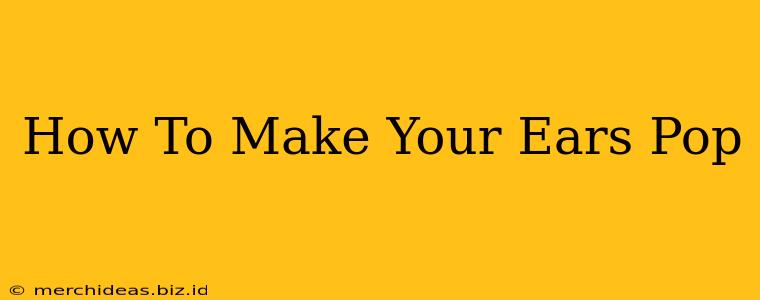Experiencing that uncomfortable pressure in your ears, that feeling of fullness or stuffiness? That's your ears popping, and it's a common sensation, especially during air travel, changes in altitude, or even just yawning. This comprehensive guide will walk you through various techniques to make your ears pop, relieve that pressure, and restore comfort.
Understanding Why Your Ears Pop
Before diving into the methods, let's briefly discuss the underlying cause. Your ears contain the Eustachian tubes, narrow channels connecting your middle ear to the back of your throat. These tubes equalize pressure between the outside world and your middle ear. When there's a pressure difference (like during ascent or descent in an airplane), the Eustachian tubes can become blocked, resulting in that unpleasant popping sensation. The popping sound is actually the sound of your Eustachian tubes opening and equalizing the pressure.
Safe and Effective Methods to Make Your Ears Pop
Several techniques can help you open your Eustachian tubes and relieve the pressure. Here are some of the most commonly used and effective methods:
1. The Valsalva Maneuver: The Classic Technique
This is the most well-known method, and it works by increasing the pressure in your throat to open your Eustachian tubes.
- How to do it: Gently pinch your nostrils closed. Close your mouth and try to exhale gently as if you were blowing your nose. You should feel a slight pop in your ears as the pressure equalizes. Important: Avoid forceful exhalation; this can be harmful.
2. The Toynbee Maneuver: A Gentler Approach
This technique is often preferred for those who find the Valsalva maneuver too forceful.
- How to do it: Close your mouth and pinch your nostrils closed. Try swallowing, and you should feel the Eustachian tubes open. You can combine this with a gentle yawn to enhance the effect.
3. The Frenzel Maneuver: For Advanced Users
This maneuver involves using your throat muscles to create pressure without blowing air. This technique may require some practice.
- How to do it: Close your mouth and gently tense the muscles in the back of your throat, as if you are trying to make a sound without actually producing one. This creates pressure to open the Eustachian tubes.
4. Yawning and Swallowing: Natural Pressure Equalization
Sometimes, simply yawning or swallowing can be enough to open your Eustachian tubes and relieve the pressure. Try yawning widely or swallowing repeatedly. Chewing gum can also stimulate swallowing.
5. Over-the-Counter Decongestants: For Severe Cases
If you're experiencing persistent ear pressure or pain, over-the-counter decongestants may provide temporary relief. These medications help reduce swelling in the nasal passages and Eustachian tubes, facilitating pressure equalization. Always consult a doctor or pharmacist before using any medication, particularly if you have underlying health conditions.
Preventing Ear Popping
While you can't always prevent ear popping, here are some preventative measures that can help:
- Stay Hydrated: Dehydration can thicken mucus, potentially obstructing the Eustachian tubes. Drink plenty of water.
- Avoid Flying When Sick: If you have a cold or other respiratory infection, flying can worsen your symptoms and make ear popping more likely.
- Gentle Pressure Changes: If possible, ascend or descend gradually to allow your body to adjust to changes in pressure more easily.
When to See a Doctor
While most ear popping is harmless, consult a doctor if you experience:
- Severe ear pain
- Persistent ear fullness
- Hearing loss
- Discharge from the ear
- Symptoms that persist for several days
These symptoms could indicate a more serious underlying condition requiring medical attention.
Remember, patience and gentle techniques are key. If you find one method isn't working, try another. With practice, you’ll master the art of making your ears pop and relieving that uncomfortable pressure.
